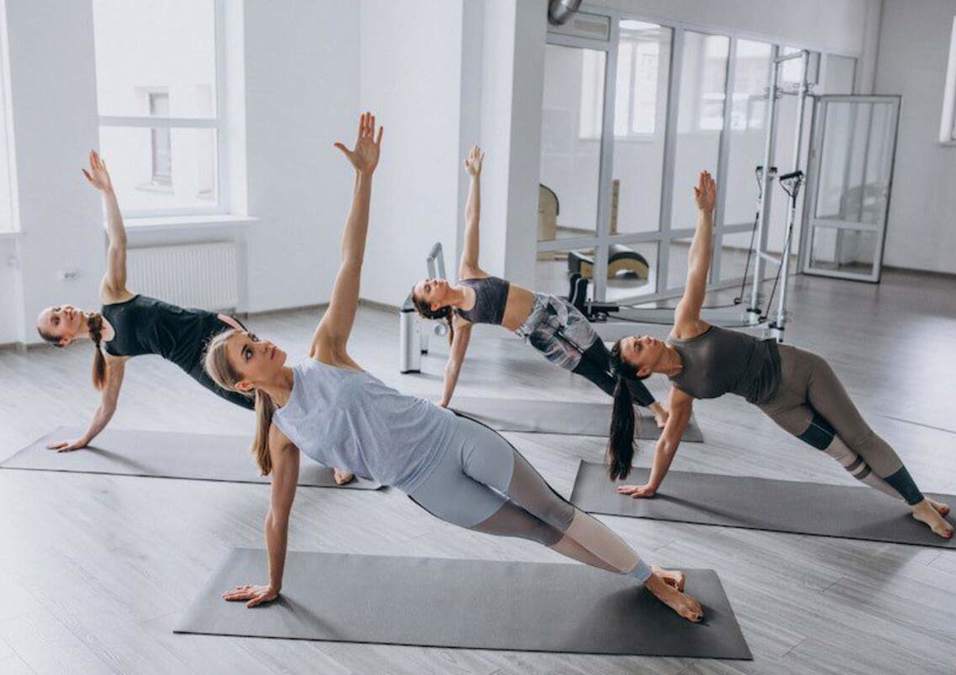Reformer vs. Mat Pilates?

SIGN UP FOR YOUR FREE DAY PASS TODAY!
If it seems like everyone around you has started doing Pilates, you're not imagining things. Pilates is trending.
According to the ClassPass 2024 Look Back Report, it was the most booked fitness class last year. Its demand continues to rise, with platforms like TikTok and Instagram overflowing with Pilates content.
There are two primary types of Pilates workouts to explore: mat Pilates and reformer Pilates.
Certified Pilates instructor Laura Scholz explains, “Mat Pilates is performed on a mat using body weight for resistance, while reformer Pilates involves a machine with springs and straps to create added resistance.”
Both styles aim to build strength, improve flexibility, and promote better posture, but the ideal choice for you may depend on your fitness goals, says Lindsay Matthews, another skilled Pilates instructor.
Wondering which Pilates method to try? Discover the advantages and disadvantages of both below.
Mat Pilates: The Basics and Benefits
Low-Impact and Joint Friendly
Mat Pilates is fantastic for those seeking a gentler workout experience. Without the added resistance of a reformer machine, it places less strain on your joints, making it a suitable option for individuals recovering from injuries or dealing with mobility challenges.
A Workout You Can Do Anywhere
No equipment? No problem. Mat Pilates requires just a mat (or even a towel) and can be practiced at home, in a hotel room, or practically anywhere. Optional accessories, like rings or sliders, can enhance the workout but aren't essential.
Potential Downsides of Mat Pilates
Requires Pre-established Strength
For those new to Pilates or fitness, mat-based movements like the "hundred" can be challenging because they demand core strength and stability without additional support.
How long is your ideal workout?
Risk of Improper Form
Group classes or at-home videos can sometimes result in improper technique, increasing the risk of pain or injury.
Matthews suggests attending a private or small-sized class to understand the correct form before practicing solo.
Reformer Pilates: Key Benefits
More Intense and Challenging
The reformer machine amplifies intensity by utilizing springs and straps that increase resistance during exercises.
Matthews describes it as a more strength-training-focused approach compared to mat Pilates. This heightened difficulty can lead to improved core engagement and muscle activation.
Supports Low-impact Strength Training
The reformer allows you to perform traditional strength movements in a low-impact setup. For instance, lying down on the reformer while doing footwork reduces pressure on your joints compared to performing squats with a barbell.
A Solution for Recovery
Reformer Pilates is often recommended by physical therapists for injury rehabilitation. The machine's design provides a stable yet challenging environment that helps correct improper movement patterns without aggravating injuries.
Improves Balance and Stability
Exercises on a moving reformer—notably those involving planks or half-squats on the carriage—further improve balance and core stability, offering challenges that mat Pilates cannot replicate.
Drawbacks of Reformer Pilates
Expense
Reformer classes tend to be more expensive, both due to the machine's cost and the extensive training instructors undergo.
A high-end reformer can cost thousands of dollars. However, some health insurance plans may cover classes if they're prescribed for rehabilitation.
Steeper Learning Curve
The springs, straps, and moving parts of a reformer can be intimidating, especially for beginners. Small-group or private instruction is ideal to ensure safety and proper use of the machine.
Shared Benefits of Mat & Reformer Pilates
Both Pilates methods offer these substantial benefits:
- Build Strength: Whether utilizing body weight on a mat or springs and straps on a reformer, both styles improve muscle tone and enhance strength.
- Enhance Posture: Strengthening the neck, core, and back muscles through Pilates supports better alignment and posture.
- Boost Flexibility: Regular practice, whether on a mat or reformer, increases range of motion, flexibility, and functional movement.
Choosing Between Mat and Reformer Pilates
Both mat and reformer Pilates have their unique advantages, and the choice often boils down to personal preference. Consider these factors:
Fitness Level
For beginners, mat Pilates is more accessible due to its simplicity and lack of equipment. That said, reformer Pilates is also beginner-friendly if you enroll in an introductory class.
Personal Goals
If you're seeking gentle, low-impact movement, mat Pilates is a great starting point. Reformer Pilates, on the other hand, is better for individuals looking to intensify their workouts or improve balance.
Budget
Mat Pilates is generally more affordable since it doesn’t require costly equipment or specialized studios. Free online videos also make it highly accessible.
Convenience
Nothing beats the flexibility of rolling out a mat for a quick workout at home or on the go. Reformer Pilates, however, requires access to specific equipment.
Injury or Special Considerations
Always consult with a healthcare provider if you have existing injuries. Reformer Pilates, used under a trained instructor’s guidance, can be especially beneficial for rehabilitation.
Final Thoughts
Pilates, whether on a mat or a reformer, has much to offer. Both styles enhance strength, flexibility, balance, and posture, making them excellent fitness choices regardless of goals or experience level.
Try both methods to determine what suits you best and aligns with your aspirations.
Source: womenshealthmag
The opinions shared in the GymNation blog articles are solely those of the respective authors and may not represent the perspectives of GymNation or any member of the GymNation team.
GET YOUR FREE TRIAL TODAY

















































































